Flame Retardancy and Toughness of Poly(Lactic Acid)/GNR/SiAHP Composites
Abstract
:1. Introduction
2. Materials and Methods
2.1. Materials
2.2. Preparation of Flame-Retardant PLA/GNR/SiAHP Composites
2.3. Characterization
3. Results
3.1. Mechanical Properties and Morphology
3.2. Thermal Stability
3.3. Flame Retardancy of PLA/GNR Composites
3.4. Char Morphology
4. Conclusions
Author Contributions
Funding
Conflicts of Interest
References
- Bourbigot, S.; Fontaine, G. Flame retardancy of polylactide: An overview. Polym. Chem. 2010, 1, 1413–1422. [Google Scholar] [CrossRef]
- Nampoothiri, K.M.; Nair, N.R.; John, R.P. An overview of the recent developments in polylactide (PLA) research. Bioresour. Technol. 2010, 101, 8493–8501. [Google Scholar] [CrossRef] [PubMed]
- Tang, G.; Wang, X.; Xing, W.Y.; Zhang, P.; Wang, B.B.; Hong, N.N.; Yang, W.; Hu, Y.; Song, L. Thermal degradation and flame retardance of biobased polylactide composites based on aluminum hypophosphite. Ind. Eng. Chem. Res. 2012, 51, 12009–12016. [Google Scholar] [CrossRef]
- Chen, C.; Gu, X.Y.; Jin, X.D.; Sun, J.; Zhang, S. The effect of chitosan on the flammability and thermal stability of polylactic acid/ammonium polyphosphate biocomposites. Carbohydr. Polym. 2017, 157, 1586–1593. [Google Scholar] [CrossRef] [PubMed]
- Ke, C.H.; Li, J.; Fang, K.Y.; Zhu, Q.L.; Zhu, J.; Yan, Q.; Wang, Y.Z. Synergistic effect between a novel hyperbranched charring agent and ammonium polyphosphate on the flame retardant and anti-dripping properties of poly(lactide). Polym. Degrad. Stab. 2010, 95, 763–770. [Google Scholar] [CrossRef]
- Guan, Y.Y.; Wen, X.; Yang, H.F.; Zhang, L.P.; Li, M.G.; Shao, J.; Li, Y.H.; Tang, T. “One-pot” synthesis of crosslinked silicone-containing macromolecular charring agent and its synergistic flame retardant poly(L–lactic acid) with ammonium polyphosphate. Polym. Adv. Technol. 2017. [Google Scholar] [CrossRef]
- Jin, X.; Gu, X.; Chen, C.; Tang, W.F.; Li, H.F.; Liu, X.D.; Bourbigot, S.; Zhang, Z.W.; Sun, J.; Zhang, S. The fire performance of polylactic acid containing a novel intumescent flame retardant and intercalated layered double hydroxides. J. Mater. Sci. 2017, 52, 12235–12250. [Google Scholar] [CrossRef]
- Wang, X.; Hu, Y.; Song, L.; Xuan, S.Y.; Xing, W.Y.; Bai, Z.M.; Lu, H.D. Flame retardancy and thermal degradation of intumescent flame retardant poly (lactic acid)/starch biocomposites. Ind. Eng. Chem. Res. 2010, 50, 713–720. [Google Scholar] [CrossRef]
- Xuan, S.Y.; Wang, X.; Song, L.; Xing, W.Y.; Lu, H.D.; Hu, Y. Study on flame-retardancy and thermal degradation behaviors of intumescent flame-retardant polylactide systems. Polym. Int. 2011, 60, 1541–1547. [Google Scholar] [CrossRef]
- Wang, D.Y.; Leuteritz, A.; Wang, Y.Z.; Wagenknecht, U.; Heinrich, G. Preparation and burning behaviors of flame retarding biodegradable poly (lactic acid) nanocomposite based on zinc aluminum layered double hydroxide. Polym. Degrad. Stab. 2010, 95, 2474–2480. [Google Scholar] [CrossRef]
- Ding, P.; Kang, B.; Zhang, J.; Yang, J.W.; Song, N.; Tang, S.F.; Shi, L.Y. Phosphorus-containing flame retardant modified layered double hydroxides and their applications on polylactide film with good transparency. J. Colloid Interf. Sci. 2015, 440, 46–52. [Google Scholar] [CrossRef] [PubMed]
- Guo, Y.C.; He, S.; Zuo, X.H.; Xue, Y.; Chen, Z.H.; Chang, C.C.; Weil, E.; Rafailovich, M. Incorporation of cellulose with adsorbed phosphates into poly (lactic acid) for enhanced mechanical and flame retardant properties. Polym. Degrad. Stab. 2017, 144, 24–32. [Google Scholar] [CrossRef]
- Kaya, H.; Hacaloglu, J. Thermal degradation of polylactide/aluminium diethylphosphinate. J. Anal. Appl. Pyrol. 2014, 110, 155–162. [Google Scholar] [CrossRef]
- Yu, T.; Tuerhongjiang, T.; Sheng, C.; Li, Y. Phosphorus-containing diacid and its application in jute/poly(lactic acid) composites: Mechanical, thermal and flammability properties. Compos. Part A App. Sci. Manufac. 2017, 97, 60–66. [Google Scholar] [CrossRef]
- Liao, F.H.; Ju, Y.Q.; Dai, X.; Cao, Y.; Li, J.W.; Wang, X.L. A novel efficient polymeric flame retardant for poly (lactic acid) (PLA): Synthesis and its effects on flame retardancy and crystallization of PLA. Polym. Degrad. Stab. 2015, 120, 251–261. [Google Scholar] [CrossRef]
- Long, L.J.; Chang, Q.F.; He, W.T.; Xiang, Y.S.; Qin, S.H.; Yin, J.B.; Yu, J. Effects of bridged DOPO derivatives on the thermal stability and flame retardant properties of poly(lactic acid). Polym. Degrad. Stab. 2017, 139, 55–66. [Google Scholar] [CrossRef]
- Chen, Y.J.; Wang, W.; Qiu, Y.; Li, L.S.; Qian, L.J.; Xin, F. Terminal group effects of phosphazene-triazine bi-group flame retardant additives in flame retardant polylactic acid composites. Polym. Degrad. Stab. 2017, 140, 166–175. [Google Scholar] [CrossRef]
- Liao, F.H.; Zhou, L.; Ju, Y.Q.; Yang, Y.Y.; Wang, X.L. Synthesis of A Novel Phosphorus–Nitrogen-Silicon Polymeric Flame Retardant and Its Application in Poly (lactic acid). Ind. Eng. Chem. Res. 2014, 53, 10015–10023. [Google Scholar] [CrossRef]
- Zhao, X.M.; Gueerero, F.R.; Llorca, J.; Wang, D.Y. New Super efficiently Flame-Retardant Bioplastic Poly(lactic acid): Flammability, Thermal Decomposition Behavior, and Tensile Properties. ACS Sustain. Chem. Eng. 2016, 4, 202–209. [Google Scholar] [CrossRef]
- Wu, N.J.; Fu, G.L.; Yang, Y.; Xia, M.F.; Yun, H.; Wang, Q.G. Fire safety enhancement of a highly efficient flame retardant poly (phenylphosphoryl phenylenediamine) in biodegradable poly(lactic acid). J. Hazard. Mater. 2019, 363, 1–9. [Google Scholar] [CrossRef]
- Jing, J.; Zhang, Y.; Tang, X.L.; Fang, Z.P. Synthesis of a highly efficient phosphorus-containing flame retardant utilizing plant-derived diphenolic acids and its application in poly lactic acid. RSC Adv. 2016, 6, 49019–49027. [Google Scholar] [CrossRef]
- Costes, L.; Laoutid, F.; Dumazert, L.; Lopez-cuesta, J.M.; Brohez, S.; Delvosalle, C.; Dubois, P. Metallic phytates as efficient bio-based phosphorous flame retardant additives for poly (lactic acid). Polym. Degrad. Stab. 2015, 119, 217–227. [Google Scholar] [CrossRef]
- Jing, J.; Zhang, Y.; Fang, Z.P. Diphenolic acid based biphosphate on the properties of polylactic acid: Synthesis, fire behavior and flame retardant mechanism. Polymer 2017, 108, 29–37. [Google Scholar] [CrossRef]
- Feng, J.B.; Sun, Y.Q.; Song, P.A.; Lei, W.W.; Wu, Q.; Liu, L.N.; Yu, Y.M.; Wang, H. Fire-resistant, strong, and green polymer nanocomposites based on Poly(lactic acid) and core-shell nanofibrous flame retardants. ACS Sustain. Chem. Eng. 2017, 5, 7894–7904. [Google Scholar] [CrossRef]
- Yin, W.D.; Chen, L.; Lu, F.Z.; Song, P.A.; Dai, J.F.; Meng, L.H. Mechanically robust, flame-retardant poly(lactic acid) biocomposites via combining cellulose nanofibers and ammonium polyphosphate. ACS Omega 2018, 3, 5615–5626. [Google Scholar] [CrossRef]
- Ojijo, V.; Ray, S.S.; Sadiku, R. Toughening of Biodegradable Polylactide/Poly (Butylene Succinate-co-adipate) Blends via in Situ Reactive Compatibilization. ACS Appl. Mater. Interfaces 2013, 5, 4266–4276. [Google Scholar] [CrossRef] [PubMed]
- Dong, W.Y.; Jiang, F.H.; Zhao, L.P.; You, J.C.; Cao, X.J.; Li, Y.J. PLLA microalloys versus PLLA nanoalloys: Preparation, morphologies, and properties. ACS Appl. Mater. Interfaces 2012, 4, 3667–3675. [Google Scholar] [CrossRef]
- Fang, H.G.; Jiang, F.; Wu, Q.H.; Ding, Y.S.; Wang, Z.G. Supertough Polylactide Materials Prepared through In Situ Reactive Blending with PEG-based Diacrylate Monomer. ACS Appl. Mater. Interfaces 2014, 6, 13552–13563. [Google Scholar] [CrossRef]
- Zhang, K.; Nagarajan, V.; Misra, M.; Mohanty, A.K. Supertoughened renewable PLA reactive multiphase blends system: Phase morphology and performance. ACS Appl. Mater. Interfaces 2014, 6, 12436–12448. [Google Scholar] [CrossRef]
- Kang, H.L.; Hu, X.R.; Li, M.Q.; Zhang, L.Q.; Wu, Y.P.; Ning, N.Y.; Tian, M. Novel biobased thermoplastic elastomer consisting of synthetic polyester elastomer and polylactide by in situ dynamical crosslinking method. RSC Adv. 2015, 5, 23498–23507. [Google Scholar] [CrossRef]
- Liu, G.C.; He, Y.S.; Zeng, J.B.; Li, Q.T.; Wang, Y.Z. Fully biobased and supertough polylactide-based thermoplastic vulcanizates fabricated by peroxide-induced dynamic vulcanization and interfacial compatibilization. Biomacromolecules 2014, 15, 4260–4271. [Google Scholar] [CrossRef] [PubMed]
- Wu, N.J.; Zhang, H.; Fu, G.L. Super-tough Poly(lactide) Thermoplastic Vulcanziates based on Modified Natural Rubber. ACS Sustain. Chem. Eng. 2017, 5, 78–84. [Google Scholar] [CrossRef]
- Chen, Y.K.; Yuan, D.S.; Xu, C.H. Dynamically vulcanized biobased polylactide/natural rubber blend material with continuous cross-linked rubber phase. ACS Appl. Mater. Interfaces 2014, 6, 3811–3816. [Google Scholar] [CrossRef] [PubMed]
- Wang, Y.H.; Chen, K.L.; Xu, C.H.; Chen, Y.K. Supertoughened biobased poly (lactic acid)–epoxidized natural rubber thermoplastic vulcanizates: Fabrication, co-continuous phase structure, interfacial in situ compatibilization, and toughening Mechanism. J. Phys. Chem. B 2015, 119, 12138–12146. [Google Scholar] [CrossRef] [PubMed]
- Wu, N.J.; Xiu, Z.X. Surface microencapsulation modification of aluminum hypophosphite and improved flame retardancy and mechanical properties of flame retardant acrylonitrile-butadiene-styrene composites. RSC Adv. 2015, 5, 49142–49152. [Google Scholar] [CrossRef]
- Wu, N.J.; Li, X.T. Flame retardancy and synergistic flame retardant mechanisms of acrylonitrile- butadiene-styrene composites based on aluminum hypophosphite. Polym. Degrad. Stab. 2014, 105, 265–276. [Google Scholar] [CrossRef]
- Qian, L.J.; Qiu, Y.; Sun, N.; Xu, M.L.; Xu, G.Z.; Xin, F.; Chen, Y.J. Pyrolysis route of a novel flame retardant constructed by phosphaphen-anthrene and triazine-trione groups and its flame-retardant effect on its epoxy resin. Polym. Degrad. Stab. 2014, 107, 98–105. [Google Scholar] [CrossRef]
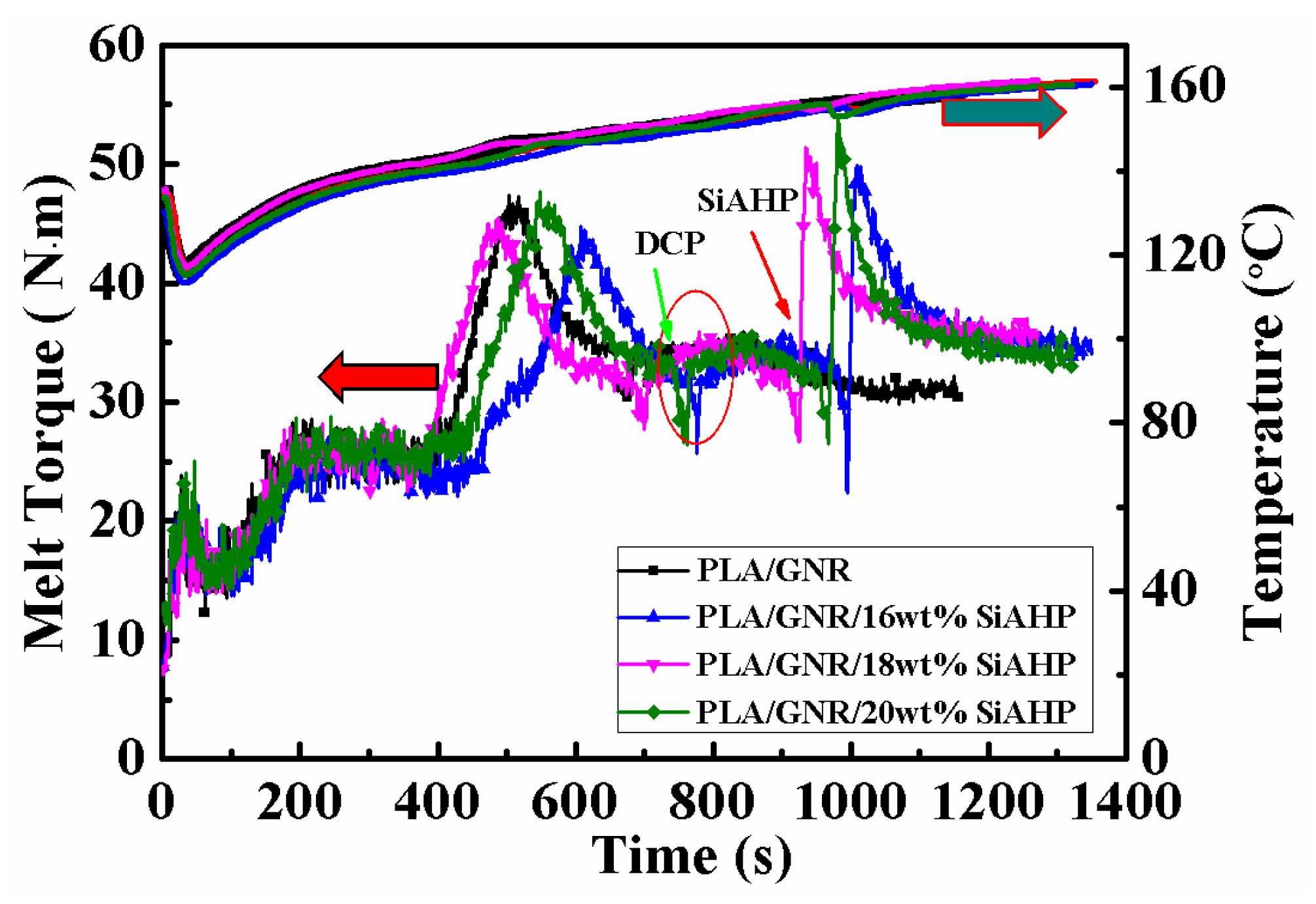
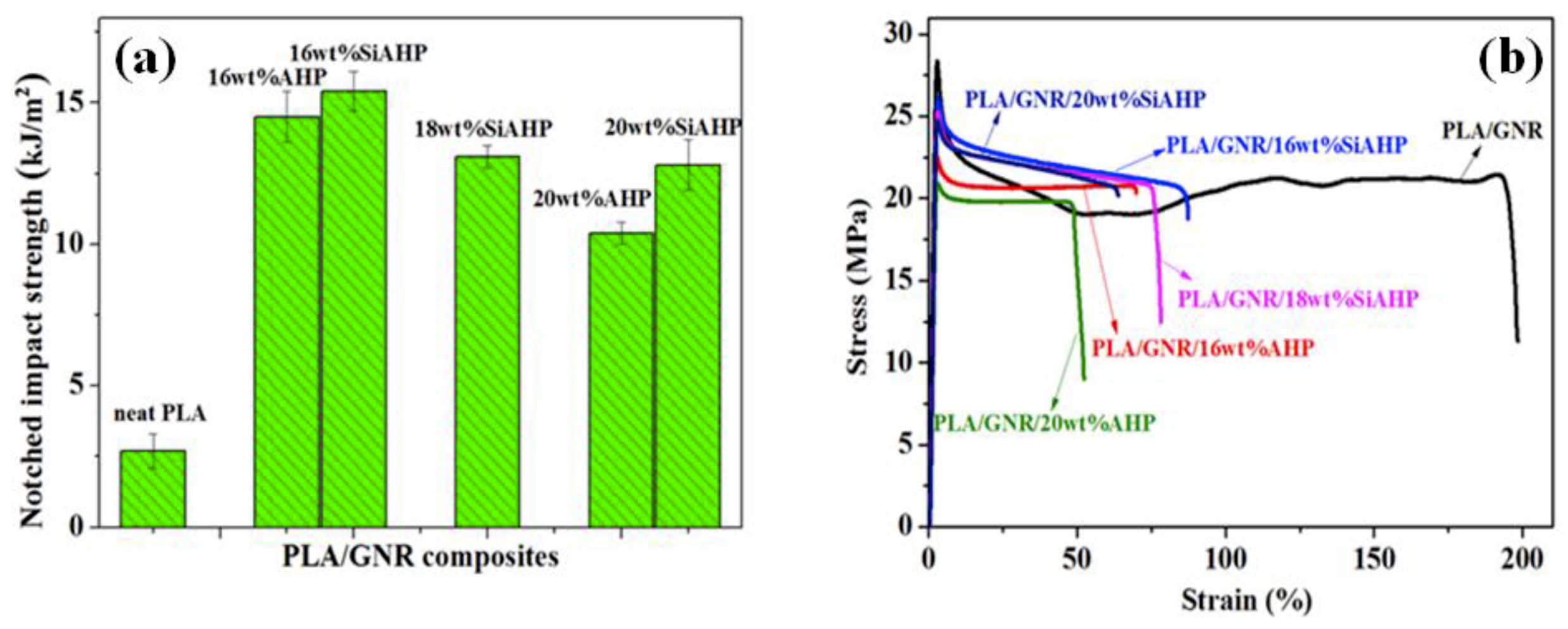
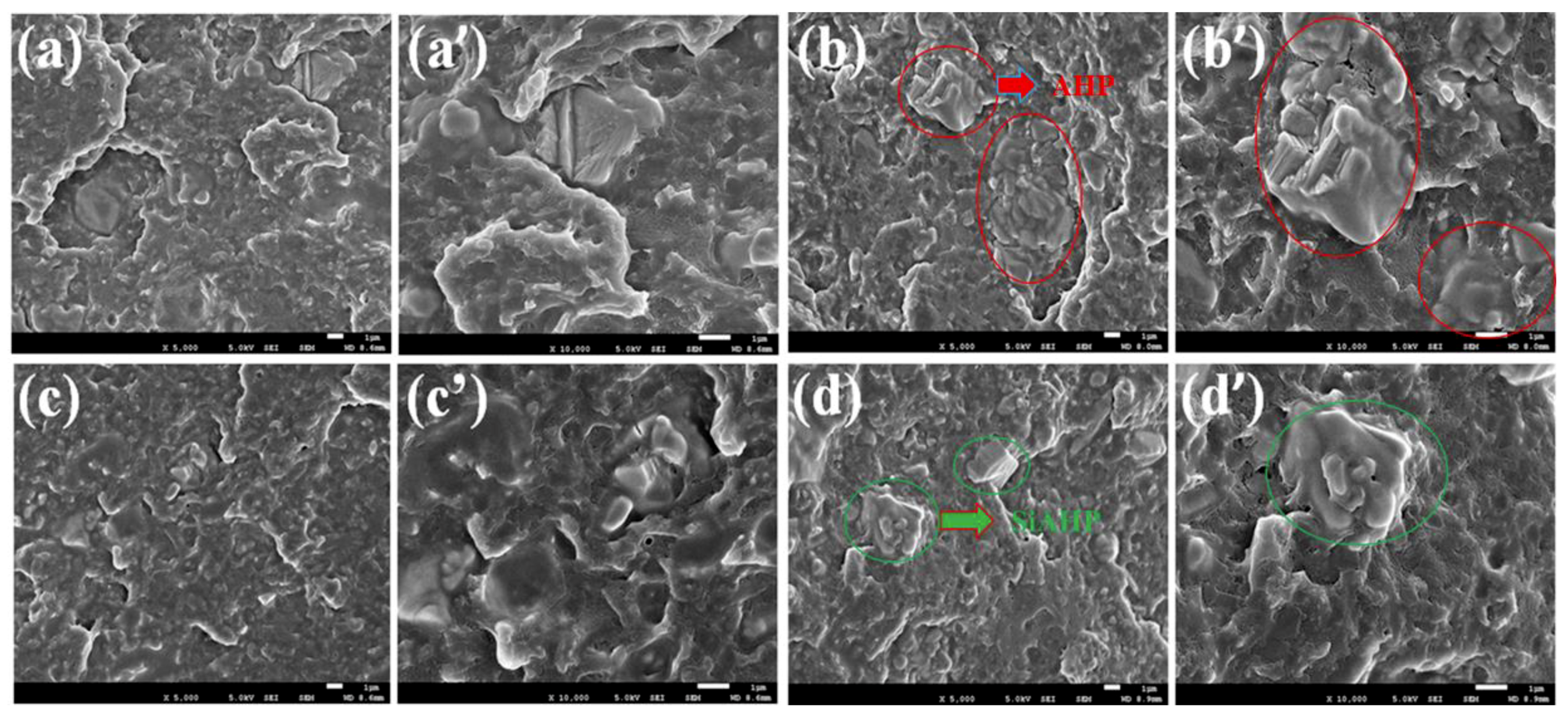
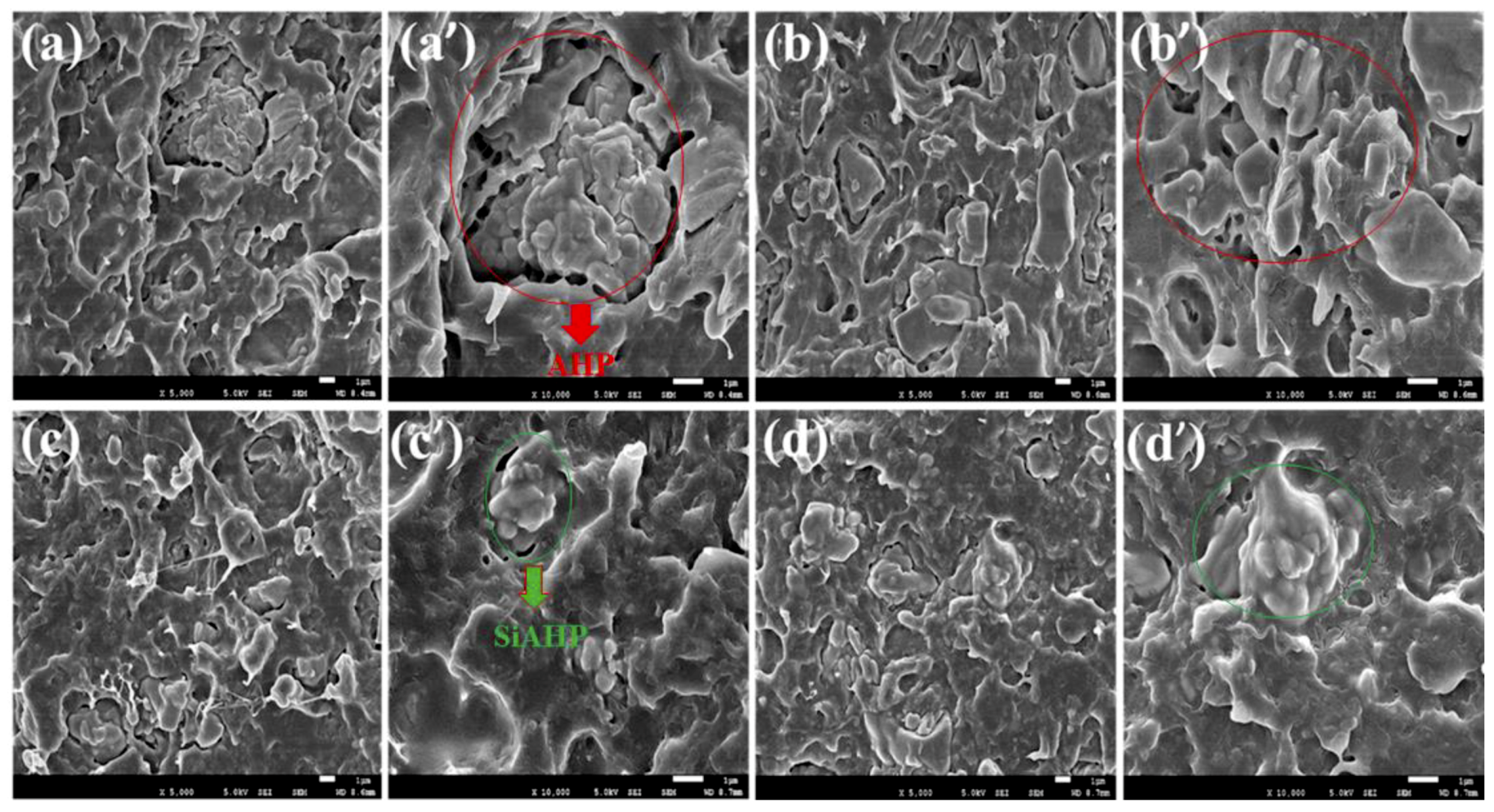
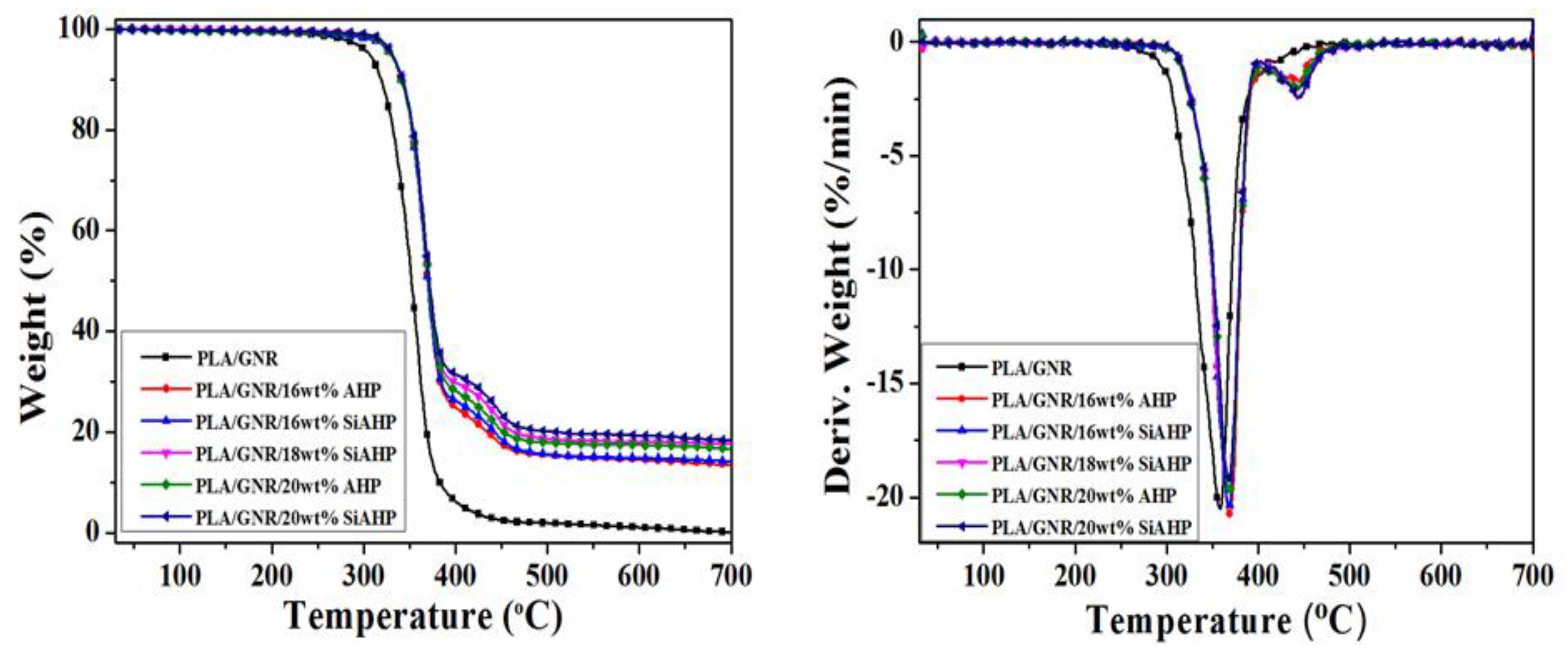
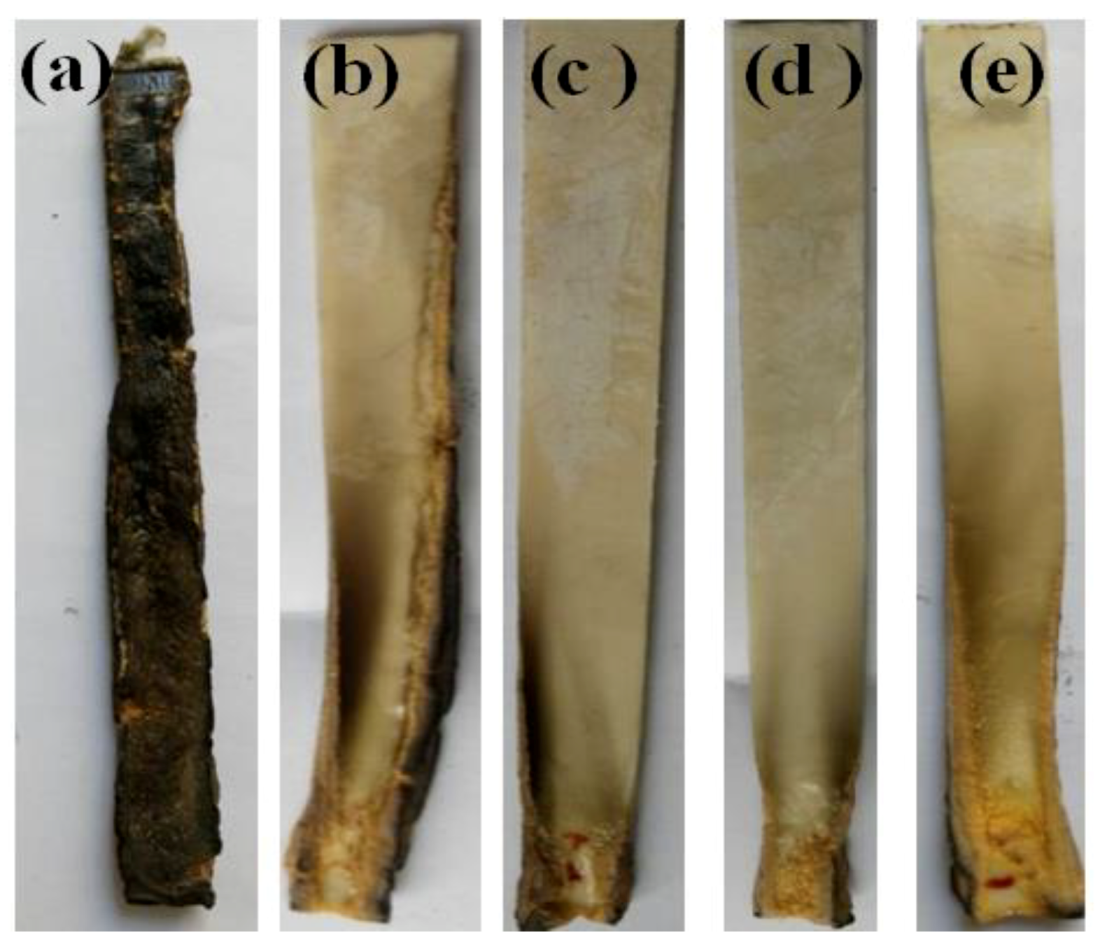
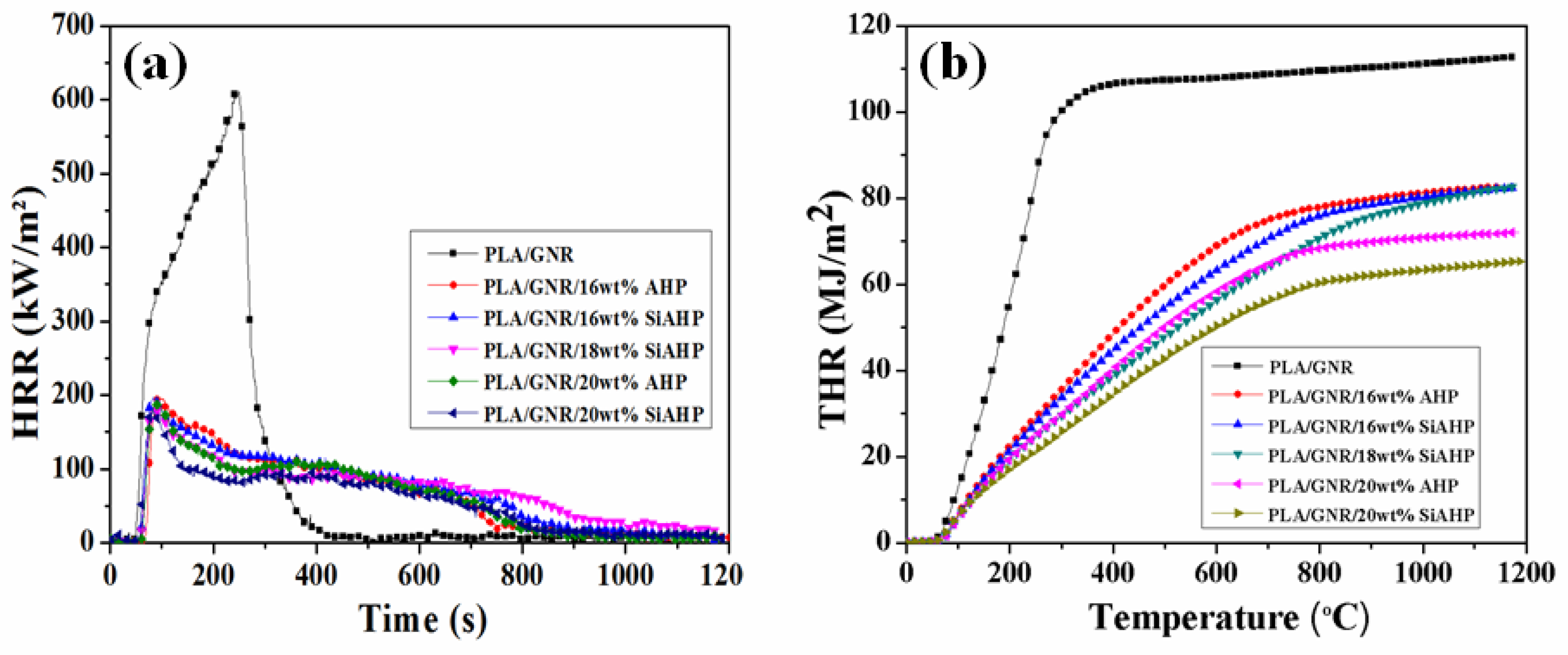

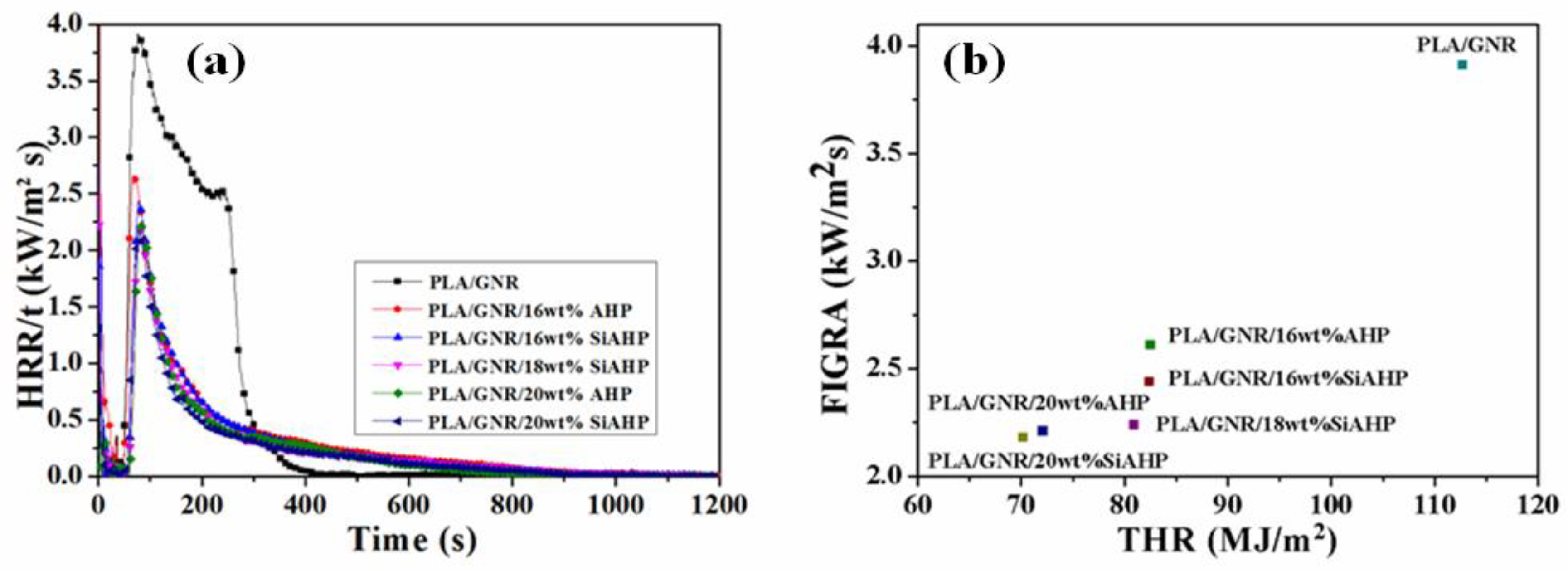

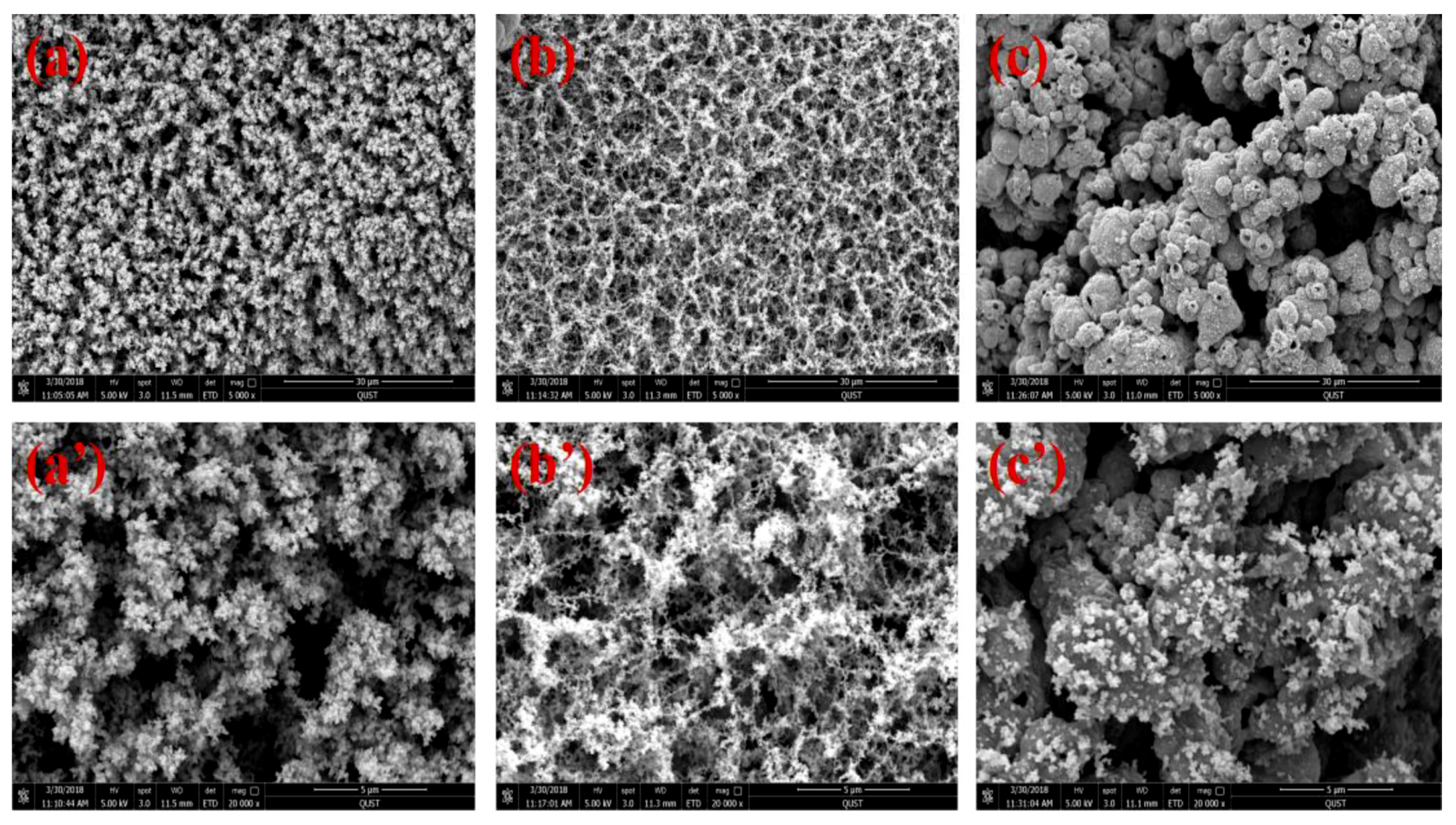
| Sample | Notched Impact Strength (kJ.m−2) | Tensile Strength (MPa) | Elongation at Break (%) |
|---|---|---|---|
| PLA | 2.7 ± 0.6 | 68.9 ± 4.1 | 4 ± 0 |
| PLA/GNR/16wt%AHP | 14.5 ± 0.9 | 22.0 ± 1.9 | 68 ± 11 |
| PLA/GNR/20wt%AHP | 10.4 ± 0.4 | 20.5 ± 0.7 | 59 ± 8 |
| PLA/GNR/16wt%SiAHP | 15.4 ± 0.7 | 25.6 ± 1.0 | 78 ± 7 |
| PLA/GNR/18wt%SiAHP | 13.1 ± 0.4 | 24.5 ± 1.4 | 72 ± 13 |
| PLA/GNR/20wt%SiAHP | 12.8 ± 0.9 | 23.1 ± 1.4 | 64 ± 8 |
| PLA/GNR | 65.0 ± 7.8 | 28.8 ± 1.2 | 183 ± 20 |
| Sample | T5% (°C) | Tmax1 (°C) | Tmax2 (°C) | Char Yield at 700 °C (%) |
|---|---|---|---|---|
| PLA/GNR TPV | 306.0 | 358.8 | - | 0.2 |
| PLA/GNR/16wt%AHP | 329.0 | 366.4 | 443.3 | 13.4 |
| PLA/GNR/20wt%AHP | 332.0 | 369.5 | 446.4 | 16.7 |
| PLA/GNR/16wt%SiAHP | 329.0 | 368.2 | 444.7 | 17.6 |
| PLA/GNR/18wt%SiAHP | 331.0 | 369.5 | 445.3 | 19.2 |
| PLA/GNR/20wt%SiAHP | 332.0 | 370.7 | 446.7 | 24.0 |
| Sample | LOI (%) | UL-94 Rating | Smoke | Dripping |
|---|---|---|---|---|
| PLA/GNR TPV | 19.0 | NR | less | Y |
| PLA/GNR/16wt%AHP | 25.5 | NR | more | N |
| PLA/GNR/20wt%AHP | 26.5 | V-0 | less | N |
| PLA/GNR/16wt%SiAHP | 26.0 | V-1 | more | N |
| PLA/GNR/18wt%SiAHP | 26.5 | V-0 | less | N |
| PLA/GNR/20wt%SiAHP | 27.0 | V-0 | no | N |
| Sample | TTI (s) | pHRR (kW·m−2) | TpHRR (s) | THR (MJ·m−2) | TSR (m2·m−2) | CR (%) |
|---|---|---|---|---|---|---|
| PLA/GNR TPV | 47 ± 2 | 612.2 ± 3.1 | 244 ± 2 | 112.7 ± 2.3 | 656.0 ± 5.3 | 0.2 |
| PLA/GNR/16wt%AHP | 58 ± 2 | 198.0 ± 1.7 | 83 ± 2 | 82.5 ± 1.6 | 1041.6 ± 3.4 | 17.6 |
| PLA/GNR/20wt%AHP | 60 ± 1 | 189.7 ± 2.1 | 86 ± 2 | 72.1 ± 1.3 | 805.8 ± 2.8 | 24.0 |
| PLA/GNR/16wt%SiAHP | 59 ± 2 | 196.9 ± 2.5 | 81 ± 1 | 82.4 ± 1.5 | 952.7 ± 3.7 | 18.0 |
| PLA/GNR/18wt%SiAHP | 61 ± 1 | 185.8 ± 1.6 | 88 ± 2 | 80.9 ± 2.0 | 789.9 ± 1.9 | 19.3 |
| PLA/GNR/20wt%SiAHP | 62 ± 1 | 178.0 ± 2.2 | 82 ± 1 | 70.2 ± 1.1 | 609.1 ± 2.8 | 26.9 |
| Sample | pHRR/tign (kW/(m2/s)) | FIGRA (kW/(m2/s)) |
|---|---|---|
| PLA/GNR TPV | 13.03 | 3.91 |
| PLA/GNR/16wt%AHP | 3.41 | 2.61 |
| PLA/GNR/16wt%SiAHP | 3.33 | 2.44 |
| PLA/GNR/18wt%SiAHP | 3.04 | 2.24 |
| PLA/GNR/20wt%AHP | 3.16 | 2.21 |
| PLA/GNR/20wt%SiAHP | 2.87 | 2.18 |
© 2019 by the authors. Licensee MDPI, Basel, Switzerland. This article is an open access article distributed under the terms and conditions of the Creative Commons Attribution (CC BY) license (http://creativecommons.org/licenses/by/4.0/).
Share and Cite
Wu, N.; Yu, J.; Lang, W.; Ma, X.; Yang, Y. Flame Retardancy and Toughness of Poly(Lactic Acid)/GNR/SiAHP Composites. Polymers 2019, 11, 1129. https://doi.org/10.3390/polym11071129
Wu N, Yu J, Lang W, Ma X, Yang Y. Flame Retardancy and Toughness of Poly(Lactic Acid)/GNR/SiAHP Composites. Polymers. 2019; 11(7):1129. https://doi.org/10.3390/polym11071129
Chicago/Turabian StyleWu, Ningjing, Jihang Yu, Wenchao Lang, Xiaobing Ma, and Yue Yang. 2019. "Flame Retardancy and Toughness of Poly(Lactic Acid)/GNR/SiAHP Composites" Polymers 11, no. 7: 1129. https://doi.org/10.3390/polym11071129
APA StyleWu, N., Yu, J., Lang, W., Ma, X., & Yang, Y. (2019). Flame Retardancy and Toughness of Poly(Lactic Acid)/GNR/SiAHP Composites. Polymers, 11(7), 1129. https://doi.org/10.3390/polym11071129





